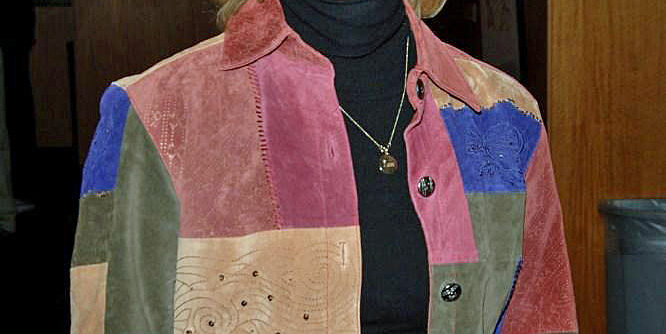Author: Steve Crum
Mediocre ‘A Dog’s Journey’ will deliver joy, tears to canine fans
 By Steve Crum
By Steve Crum
If you loved 2017’s A Dog’s Purpose, you will love this sequel, A Dog’s Journey. If you adored W. Bruce Cameron’s 2010 best selling book, A Dog’s Purpose, and/or his 2012 best seller, A Dog’s Journey, you will adore A Dog’s Journey, opening today. More inclusively, if you are a dog lover, A Dog’s Journey is definitely up your Alpo alley.
Might as well add that Cameron co-wrote the screenplays to both films. Gail Mancuso, director of TV’s Modern Family, 30 Rock, and more, directs Journey, her first motion picture.
The screening audience, which was packed with kids and families, reacted to A Dog’s Journey with laughs and “Aw’s” —as well as quiet sobs and tears. I was right there  with them, reacting the same way. Even though I have not owned a dog for decades, the schmaltz meter on this movie still grabbed my heart. Bring tissues. In Fido parlance, it’s face-lickin’ good.
with them, reacting the same way. Even though I have not owned a dog for decades, the schmaltz meter on this movie still grabbed my heart. Bring tissues. In Fido parlance, it’s face-lickin’ good.
NOTE: Be aware that the emotional reaction does not mean the film is perfect. Far from it.
The premise of A Dog’s Journey is the same as its predecessor: “Life is about having fun, saving others, not getting caught in the past or regrets, finding someone to live with, and living for today.” The focus is on Bailey, an aging St. Bernard-Austrian Shepherd, owned by farmer Ethan Montgomery (Dennis Quaid). It turns out that Bailey is actually reincarnated from a dog named Toby, Ethan’s childhood pet—long deceased.
 Flash forward to years later when Ethan and his wife Hannah (Marg Helgenberger) are still maintaining the farm, but also taking care of their recently widowed daughter-in-law, Gloria (Betty Gilpin), and toddler granddaughter, CJ. Because of Gloria’s depression, compounded by alcoholism and paranoia, Gloria angrily takes CJ with her, vowing never to let the in-laws see her or CJ again. Time passes, and a heartbroken Ethan tells his dying Bailey to “protect and never quit looking” for CJ. With a more specific purpose in life, Bailey dies, only to live again in a succession of reincarnations in other dogs. One at a time, they continue on the lookout for CJ, who eventually grows into womanhood.
Flash forward to years later when Ethan and his wife Hannah (Marg Helgenberger) are still maintaining the farm, but also taking care of their recently widowed daughter-in-law, Gloria (Betty Gilpin), and toddler granddaughter, CJ. Because of Gloria’s depression, compounded by alcoholism and paranoia, Gloria angrily takes CJ with her, vowing never to let the in-laws see her or CJ again. Time passes, and a heartbroken Ethan tells his dying Bailey to “protect and never quit looking” for CJ. With a more specific purpose in life, Bailey dies, only to live again in a succession of reincarnations in other dogs. One at a time, they continue on the lookout for CJ, who eventually grows into womanhood.
 It is both a corny and compelling fantasy, of course. Yet it is so packaged in love and redemption, who can avoid the emotional impact of A Dog’s Journey?
It is both a corny and compelling fantasy, of course. Yet it is so packaged in love and redemption, who can avoid the emotional impact of A Dog’s Journey?
Without getting too spoiler-specific, plot elements include parental abuse, sexual assault, mental cruelty, cancer, aging, and death. (Your typical family film.) Of course, death in terms of dogs is only a somewhat temporary, transitional state of being—or been.
For example, Bailey goes through three more doggy personas (Molly, Max, Toby), each varying in breed and sex. That said, A Dog’s Journey has a scattershot story line, covering many years and leaving plot holes and unanswered questions. Coincidences 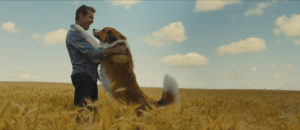 abound to the point of ridiculousness. Bring a calculator for the final tally.
abound to the point of ridiculousness. Bring a calculator for the final tally.
Acting, particularly by Gilpin, Abby Ryder Fortson (young CJ), and Kathryn Prescott (older CJ), is a bit above average. Quaid adds a plus to any film.
Finally, there are kudos for Josh Gad. He voices each dog’s thoughts, providing us with both cute and touching personifications.
=====
It is sadly coincidental that Doris Day died earlier this week at 97. Day was internationally known as both a movie star/singer AND a dog lover/animal rights activist. No doubt she would have enjoyed A Dog’s Journey, despite its flaws.
=====
GRADE on A to F Scale: C
Dee Wallace Stone affectionately remembers her KCK roots
Originally published in The Kansas City Kansan newspaper on Aug. 22, 1997, this story on KCK’s own Dee Wallace (then called Dee Wallace Stone) was and is a personal plus for me. Dee and I were on Wyandotte High School’s Pantograph newspaper staff at the same time (54 years ago)—she as a junior cub reporter, and I as a senior staffer. It was a blast interviewing her. Dee has never slowed down, and has maintained an impressive list of acting credentials that continues to grow. To date, Dee has acted in 247 movies and TV shows. She has been featured on Amazon TV’s family series, “Just Add Magic,” since 2015.
 By Steve Crum
By Steve Crum
Motherhood is integral to the persona and person of Dee Wallace Stone. Besides her most famous role as Drew Barrymore and Henry Thomas’ mother in the indelible E.T. the Extra-Terrestrial, Wallace Stone’s film and TV career is peppered with momma parts. Seven years after E.T., life copies art. Her daughter Gabrielle is born.
Wallace Stone recalled her movie and real life roles in a phone interview last week. It was a kick talking to her, especially since I had never met her even though we had graduated a year apart (I am older) from good old Wyandotte High School. During those days, I appreciated and admired Deanna Bowers from afar. I saw her perform in plays, most notably the title role in Tammy Tell Me True (yes, the Sandra Dee part). As photographer for the school newspaper, The Pantograph, I also took pictures of her at dress rehearsal. She was a gifted gem then, and still is.
She and Ed Asner both graduated from Wyandotte, and both represent the most world famous duo of thespians ever from KCK. Before Ms. Wallace Stone contemplates pummeling me, I add that Asner graduated from Big Red many years before she.
Born and raised here, Wallace Stone has a collage of KCK memories. “Of course I remember Peters Drive-in,” the long time teen hangout and drive through that has been closed for several years now. “I went back every time I came to Kansas City, Kansas.” The County Club Plaza is still high on her list of places to visit whenever she returns.
REMEMBERING KCK
More memories, and her voice has an emotional break. It is the tear in the throat sound that embellishes her mother roles. Except this time Dee is not acting. She recalls some loved ones who happen to be two of KCK’s most revered.
“Judge Bill and Donna Robinson,” she muses, “took me through a tough time when my dad died.” Incidentally, Dee’s vibrant mother, Maxine, still lives in KCK, and remarried several years ago.
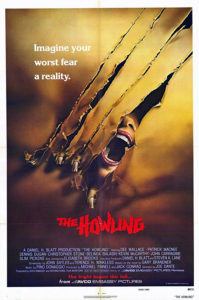 Recalling the year she taught theater and English at Washington High School (also in KCK), Wallace Stone attributes the Wildcat library as the first step of a significant career leap.
Recalling the year she taught theater and English at Washington High School (also in KCK), Wallace Stone attributes the Wildcat library as the first step of a significant career leap.
“I was reading a copy of The New York Times, and saw a classified ad placed by Broadway producer Hal Prince,” she said. The show being cast was A Little Night Music. She wrote back, and included her resume. Delightfully shocking Dee, Prince responded, offering to fly her to New York for an audition. Fast forward to Broadway. Dee did not get the part after all. (“I couldn’t sing.”) She stays anyway, picking up work in commercials and industrial films. She takes singing lessons. She dances; in fact, she runs a dance school.
Then a small TV part, and after two years in NYC, Dee has a breakthrough role (as a hooker) on Ed Asner’s great Lou Grant TV show. After a 1979 casting call to Los Angeles, the then billed Dee Wallace has a heralded performance as a prostitute in Blake Edwards’ film, 10. Remember her enticing Dudley Moore?
A terrific turn as a reporter caught up in a werewolf community established Dee as a leading actress. The movie is Joe Dante’s 1981 horror classic, The Howling. (Fortunately, she did not appear in the five, count ‘em, inferior sequels.)
PHONING HOME
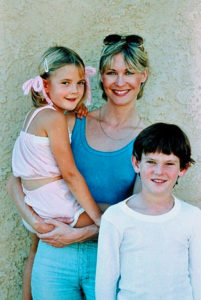
 Director Steven Spielberg takes note, and obviously sees Wallace Stone in a diverse mold, that of “E.T.’s mother,” in 1982’s E.T. the Extra-Terrestrial. This was followed by work again as a mom. In fact, she portrays a super mom who protects her sickly son from a rabid St. Bernard throughout most of the intense 1983 thriller, Cujo. This is my choice for her best work so far.
Director Steven Spielberg takes note, and obviously sees Wallace Stone in a diverse mold, that of “E.T.’s mother,” in 1982’s E.T. the Extra-Terrestrial. This was followed by work again as a mom. In fact, she portrays a super mom who protects her sickly son from a rabid St. Bernard throughout most of the intense 1983 thriller, Cujo. This is my choice for her best work so far.
The future includes a short-lived TV sitcom, Together We Stand, which suffers through the 1986-87 season. At mid-point, co-star Elliott Gould’s character is killed off, and the title changes to boost ratings. But Nothing is Easy proves prophetic. Still, Wallace Stone looks back at it wistfully. “I really loved that show. It should have done better.” 
Now she would like to do another sitcom, but only if she is part of an ensemble cast. Otherwise it would take too much time away from raising her daughter.
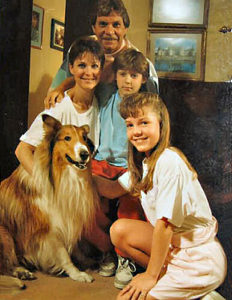 She gets another TV series, but this time things have changed. She has married Cujo and Howling co-star Christopher Stone, and they have a baby. With the assurance that filming could be wrapped around raising Gabrielle and that a large trailer is available on the set to accommodate the entire family, the Stones contract for The New Lassie. The syndicated series lasts from 1989-92.
She gets another TV series, but this time things have changed. She has married Cujo and Howling co-star Christopher Stone, and they have a baby. With the assurance that filming could be wrapped around raising Gabrielle and that a large trailer is available on the set to accommodate the entire family, the Stones contract for The New Lassie. The syndicated series lasts from 1989-92.
In the ensuing years, Dee has gotten more TV work, including several TV movies. She continues touring the country, teaching acting, camera, and editing at workshops. One is this coming Saturday and Sunday, Aug. 23-24, at Johnson County Community College. (Call 262-4500 for information. Cost is $250.)
But everything stops two years ago. Her husband, Christopher, dies suddenly. Her career is understandably put on hold.
Eventually, there is more TV work, and a chilling role in the much underrated Michael J. Fox starrer, The Frighteners. And this last March, she remarries. Skip Belyea, a producer- director-writer, is her partner in film 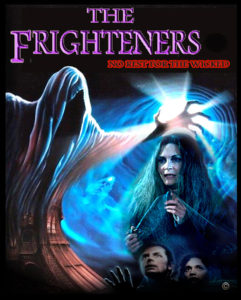 workshops as well. His love and caring for both her and Gabrielle is apparent through Dee’s tone when she speaks of him. She obviously feels likewise.
workshops as well. His love and caring for both her and Gabrielle is apparent through Dee’s tone when she speaks of him. She obviously feels likewise.
Now the Dee career is barreling. She just completed a TV movie in Toronto that will be aired in November: Bad As I Wanna Be: The Dennis Rodman Story. She plays the farm wife who helped nurture Rodman early on. (Rodman is played by first time actor, Dwayne Adway.)
Then there is that yet released film, Nevada, in which she plays a lesbian. Kirstie Alley also stars.
Earlier this week, in Kansas City with her husband and daughter, Dee visited relatives and friends. She also threw out a baseball at a Royals game, and dressed up as a Chiefs cheerleader for Dick Clark at the third anniversary celebration of his American Bandstand restaurant in Overland Park.
Dee Wallace Stone’s eventful career, by her own doing, continues to be a shared, family thing. As the screen’s premier momma, it all fits.
Having coffee with Tom Corbett, Space Cadet
First published in my Kansas City Kansan weekly column on Oct. 24, 1997, this Crum on Film piece details an encounter with one of my childhood idols, Frankie Thomas (1921-2006), who portrayed the heroic Tom Corbett, Space Cadet, on no less than four networks in the early days of television.
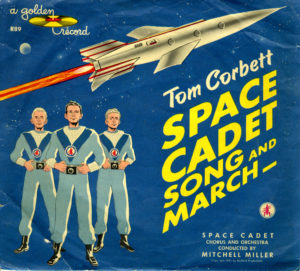 By Steve Crum
By Steve Crum
Sunday meant breakfast with an astronaut and lunch with a soldier. Clarification: I shared a morning coffee and conversation with Tom Corbett, Space Cadet, and lunched in the same theater where Corporal Agarn of F-Troop performed.
True translation: I spent about an hour talking with veteran movie-TV star Frankie Thomas (now called Frank Thomas), and then rushed off to the New Theater Restaurant in Overland Park to catch the funny Larry Storch in the wild farce, Funny Money. It was Nostalgia City all day.
Thomas, as any red blooded 50-something male knows, starred for years in the fondly recalled TV sci-fi series, Tom Corbett, Space Cadet. Running from 1950-56, the show was broadcast live, used innovative (for the time) special effects, and sold tons of boxes of Kellogg’s Pep Cereal. I made a retro-jump this last weekend when I learned that Thomas, now 75, was appearing at the Fall Kansas City Comic Book Convention at Reardon Center in Kansas City, Kansas.
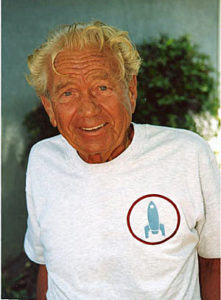 Beneath the gray, wavy hair and deep tan, there was the greatest space adventurer of the next century. I felt compelled to salute. But he stood in front of his table area, all five and a half feet of him in slacks and sports shirt. No need for propriety. Flanking his table was Tom Corbett memorabilia that included toy phasers and space ships, and an authentic Space Cadet uniform. Jumping Jupiter!
Beneath the gray, wavy hair and deep tan, there was the greatest space adventurer of the next century. I felt compelled to salute. But he stood in front of his table area, all five and a half feet of him in slacks and sports shirt. No need for propriety. Flanking his table was Tom Corbett memorabilia that included toy phasers and space ships, and an authentic Space Cadet uniform. Jumping Jupiter!
“How do you account for all the nostalgia?” I asked. “They were simpler times,” said Frank, “innocent times. People like to remember.” Frankie Thomas, the juvenile actor, seemed to emerge as he began delving into the olden days. He then invited me to join him for coffee as he headed for the break room. Of course, I went.
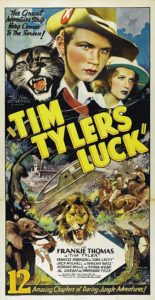 Sipping coffee, Frankie reminisced about his curly haired teen years in the serial Tim Tyler’s Luck (1937), and as Bonita Granville’s co-star (portraying Ted Nickerson) in the Warner Brothers Nancy Drew series, based on the popular books. (Of the four movies produced from 1938-39, look for two of them on Turner Classic Movies in November.) Granville later married Jack Wrather and became co-owner of The Lone Ranger and Lassie empire. Thomas joked about a recurring problem encountered during the Drew series.
Sipping coffee, Frankie reminisced about his curly haired teen years in the serial Tim Tyler’s Luck (1937), and as Bonita Granville’s co-star (portraying Ted Nickerson) in the Warner Brothers Nancy Drew series, based on the popular books. (Of the four movies produced from 1938-39, look for two of them on Turner Classic Movies in November.) Granville later married Jack Wrather and became co-owner of The Lone Ranger and Lassie empire. Thomas joked about a recurring problem encountered during the Drew series.
“It was Bonnie’s bust,” he said. “Nancy Drew was supposed to be a juvenile detective, so Bonnie’s chest had to be strapped down to fit the image. It made it very uncomfortable for her.”
Thomas told of Granville’s attempts to steal scenes. “In one scene, we were sitting at a table, side-by-side. Bonnie knew that the camera would stay with the person who moves, so she found ways of adjusting her chair, moving it back or to the side. Then we broke for lunch. On our return, someone had nailed boards around her chair legs so she couldn’t move it anymore.”
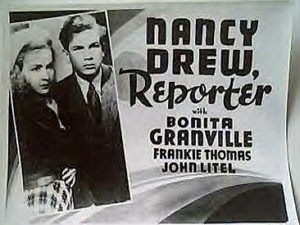 Thomas, who was featured as the juvenile mayor in the Spencer Tracy-Mickey Rooney great, Boys Town (1938), also co-starred in Angels Wash Their Faces (1939), The Major and the Minor (with Ginger Rogers—1942), and my personal favorite, One Foot in Heaven (1941). The latter, starring Frederic March as a Methodist minister in turn-of-the-century rural America, has a memorable scene of March’s Rev. William Spence hesitantly taking his teen son, Hartzell, to a silent movie…and loving it.
Thomas, who was featured as the juvenile mayor in the Spencer Tracy-Mickey Rooney great, Boys Town (1938), also co-starred in Angels Wash Their Faces (1939), The Major and the Minor (with Ginger Rogers—1942), and my personal favorite, One Foot in Heaven (1941). The latter, starring Frederic March as a Methodist minister in turn-of-the-century rural America, has a memorable scene of March’s Rev. William Spence hesitantly taking his teen son, Hartzell, to a silent movie…and loving it.
In all, Frankie Thomas had featured roles in eight Broadway shows, and 30 TV shows and motion pictures.
 After the Corbett series was canceled, Frankie Thomas wrote and produced several TV shows of the 1950s, including My True Story and Four Star Theater. His writing has included 10 Sherlock Holmes novels, two of them related to bridge, the card game. The Sherlock Holmes Bridge Book, in fact, is a semifictional instruction book. For years Frank Thomas has lectured about and taught contract bridge to thousands around the country. He had just come from a Phoenix bridge seminar, and headed back home to Los Angeles to instruct 150 students this last Monday morning. Then he flew here for the comic book convention.
After the Corbett series was canceled, Frankie Thomas wrote and produced several TV shows of the 1950s, including My True Story and Four Star Theater. His writing has included 10 Sherlock Holmes novels, two of them related to bridge, the card game. The Sherlock Holmes Bridge Book, in fact, is a semifictional instruction book. For years Frank Thomas has lectured about and taught contract bridge to thousands around the country. He had just come from a Phoenix bridge seminar, and headed back home to Los Angeles to instruct 150 students this last Monday morning. Then he flew here for the comic book convention.
Frankie then grew sullen, and talked of his marriage. “I held out as a bachelor until 12 years ago,” he said, “and finally got married.” Sadly, a month ago his wife Virginia died. So Thomas is soon moving into a condo. “I need to be there right now,” he added. “I have so much to do back home.”
Thanks for landing here Frankie, and “Spaceman’s Luck” for your future.
Reflections on Pat Paulsen
Originally published May 9, 1997, my remembrances of comedian Pat Paulsen covered the two times our paths crossed. My first paragraph references the fact the name of my weekly Kansas City Kansan newspaper column was “Crum on Film.” Paulsen was basically a non-movie comedian-satirist. But he did appear in small roles in a half dozen flicks, the best being Doris Day’s “Where Were You When the Lights Went Out?”
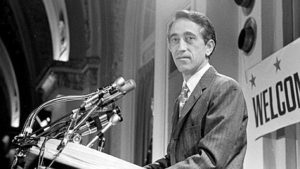 By Steve Crum
By Steve Crum
For the life of me I cannot recall Pat Paulsen ever making a movie. But then again, there is a gnawing recollection of him starring in a Phyllis Diller grade-Z comedy in the late 1970s. I am probably confusing him with Bob Denver. No matter. The truth is that the Paulsen’s media were TV, live appearances (for the most part “campaigning” for President of the United States), and writing. His writing encompassed several books (collections of his political essays and one-liners) and his brilliant TV and mock-political scripts.
Just reading the text of his political bits is funny enough, but Paulsen’s basset hound delivery made them hilarious. Try not to hear Paulsen’s deadpan tone in this excerpt from his March 19, 1997 editorial on “Should the Use of Firearms Be Restricted?,” delivered on the show that launched his career, The Smothers Brothers Comedy Hour:
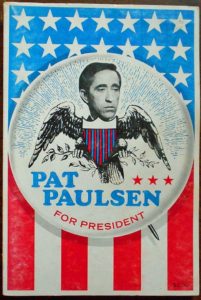 •”Many people today are suggesting that restrictions be placed on the purchase and ownership of firearms. We respect them, and we will fight to the death against their right to express their opinions.
•”Many people today are suggesting that restrictions be placed on the purchase and ownership of firearms. We respect them, and we will fight to the death against their right to express their opinions.
•”We are merely talking about simple firearms: pistols, rifles, and bazookas. I ask you what is our most cherished right since pioneer days? The right for every man, woman, and child to carry a gun.
•”A gun is a necessity. Who knows when you’re walking down the street and you’ll spot a moose? We at the Smothers Brothers Corporation consider this a personal plot on our integrity. Now personally, I myself carry a gun. DO I LOOK UNSTABLE? Let no man take away our liberties,. Stand up and be counted. Let’s preserve our freedom to kill. Thank you.”
Funny Pat Paulsen. His recently reported April 24 death at 69 in Mexico, after pneumonia and kidney failure, saddened me greatly. I was privileged to cross paths with him twice, the first time in his dressing room at the Civic Auditorium in Emporia, Kansas—not long after he delivered the previous editorial on TV. It was presidential candidate Pat Paulsen then, and he was touring with the Back Porch Majority. It was Paulsen’s first of six campaigns, and playing to the Emporia State (then Kansas State Teachers College) audience was part of what he later recalled as being a “grueling, non-stop schedule.” As Associate Editor and media critic of the college newspaper, The Bulletin, I had the happy duty of covering Paulsen.
After the show, a half-dozen local press surrounded a sweating, even more saggy-faced-up-close Paulsen as he did his best to continue the show with quips and one-liners to reporters’ questions. Paulsen was still playing the comedy prez candidate, and we were an extended audience. Paulsen sat opposite center of a long table in his crammed dressing area. Beside him, standing, his manager guided all questions, cutting off the pseudo-interview in exactly 20 minutes.
Funny how reporters flutter in the face of celebrity. I have seen it happen again and again. The second the ordered and composed interview is over, reporters invariably rush the star for autographs. Paulsen expected such, and handled it with aplomb, pulling out a stamp pad and stamper. “Here you go,” he said, and proceeded to ink “Stamped by Pat Paulsen” on each received page.
THEN THERE WAS 23 YEARS LATER
 On March 25, 1990, Pat Paulsen was in the midst of a rough custody battle with his ex-wife. Among other issues was the ownership of the Pat Paulsen Vineyards located in Sonoma County outside of Santa Rosa, California. The vineyards included an incorporated town consisting of several buildings, and Paulsen’s award winning wine. (Paulsen’s close friends, Tommy and Dick Smothers, have their own wineries in the area.)
On March 25, 1990, Pat Paulsen was in the midst of a rough custody battle with his ex-wife. Among other issues was the ownership of the Pat Paulsen Vineyards located in Sonoma County outside of Santa Rosa, California. The vineyards included an incorporated town consisting of several buildings, and Paulsen’s award winning wine. (Paulsen’s close friends, Tommy and Dick Smothers, have their own wineries in the area.)
On spring break from teaching, and visiting my Santa Rosa sister, we pulled into Paulsen’s winery, one of dozens of assorted wineries located along Sonoma County roads. Free taste tests are featured at all of them. Maybe once every year or so, I later learned, Paulsen himself appeared at his wine land. Today was that day. Three other customers were there, in addition to my sister, her husband, and me. A two-man camera crew from a tabloid TV show was preparing to shoot a piece on Paulsen’s property dilemma. And there was the legendary political candidate himself, now white-haired and droopier-faced, pacing about his parking area.
After buying his wine (labeled “My wine has been served in the White House, even if I haven’t”) plus a copy of his Pat Paulsen For President book, I approached him. He responded cordially, signed his autograph (no stamping this time), and humorously posed for video shots with me and my family. After we talked about his life in show business, which included his 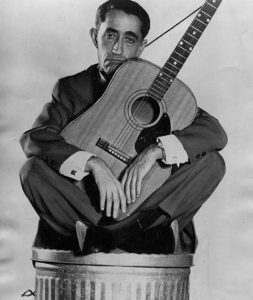 total non-recollection of Emporia (“There were hundreds of towns and concerts”), the TV crew filmed away—focusing on Paulsen and his troubles only, excluding my family.
total non-recollection of Emporia (“There were hundreds of towns and concerts”), the TV crew filmed away—focusing on Paulsen and his troubles only, excluding my family.
This time Pat Paulsen, starkly alone and definitely not “on,” spoke with and not at his TV audience. He was refreshingly candid. (Incidentally, his ex eventually got the winery.)
At this writing, several Paulsen sponsored Internet pages are in full operational form. At least they give that appearance. Speculation enters, however. Maybe Paulsen planned to resume the pages after a sojourn south of the border for radical colon and brain cancer treatments. “Be back before you can spell ‘presidential,’” maybe he thought. The cyber messages that tout Paulsen quips and merchandizing now appear frozen in html time.
The messages are there, but the very funny, sad faced messenger is gone.
‘Whizzo’ looks at baby boomer kiddie shows
 Published in The Kansas City Kansan on Sept. 20, 1996, this Crum on Film column offering essentially promotes the rebroadcast of a two-hour documentary, produced by Kansas City’s Public Television affiliate, KCPT. Since I am featured in the program, sharing my memories of Commander 9 and Gregory Grave, it was appropriate I would write what is purely a nostalgia piece for KC baby boomers. Sadly, the program has not been rebroadcast for several years. Neither has it ever been available on DVD. But it was once sold via VHS. YouTube has a teaser clip only.
Published in The Kansas City Kansan on Sept. 20, 1996, this Crum on Film column offering essentially promotes the rebroadcast of a two-hour documentary, produced by Kansas City’s Public Television affiliate, KCPT. Since I am featured in the program, sharing my memories of Commander 9 and Gregory Grave, it was appropriate I would write what is purely a nostalgia piece for KC baby boomers. Sadly, the program has not been rebroadcast for several years. Neither has it ever been available on DVD. But it was once sold via VHS. YouTube has a teaser clip only.
By Steve Crum
Maybe Crum on Video is more appropriate this week, since we are returning to those thrilling days of yesteryear via video tape and film clips recalled in Whizzo, Ol’ Gus & Me. If you happened to miss it the first time around, the locally produced 120 minute documentary will be rebroadcast in two parts on KCPT-Channel 19 at 8:30 p.m. this Sunday and Monday, Sept. 22 and 23.
Many have already seen it, but will want to tune in again. It taps directly into a Kansas City baby boomer’s memory vault. That is where all the Whizzo-dust and Cousin Ken’s straw hats are carefully stored.
Produced and directed by the extraordinary Teddy Dibble, who geniused last year’s heralded documentary of the Kansas City Monarchs, Whizzo, Ol’ Gus & Me is a fast, fun, and nostalgic album of locally produced children’s show from the late 1940s to the early 1970s.
Dibble worked overtime to gather this cast and crew together. Vintage clips, including privately shot color and 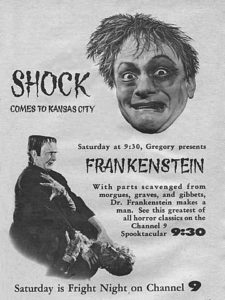 black and white footage, are sandwiched with recent interviews of the original stars. The result is an awesome, polished, and warm-hearted two hours.
black and white footage, are sandwiched with recent interviews of the original stars. The result is an awesome, polished, and warm-hearted two hours.
Among the nostalgic local stars and clips featured are Gregory Grave (Shock!), Miss Virginia (Romper Room), Fred Broski, and Marilyn the Witch.
My desired interest in the show is not just that I am fleetingly featured as one of the recalling viewers. Television ws a huge part fo my childhood. Being born in the late 1940s means that I was part of the first generation to experience TV. Whizzo, Ol’ Gus & Me reminded me that the very reason to this day I am a collector, obsessively so, of B-westerns is because of KCMO-TV’s Uncle Ezra on Frontier Theater. How often as a preteen I buckled on my double fostered cap guns after an hour with Uncle Ezra, and rounded up my KCK neighborhood buddies Corky Green, Bobby Sixta, and Don Thompson to reenact The 3 Mesquiteers latest adventure (I was always Stony Brook, the Bob Livingston character) or Johnny Mack Brown shooting it out with the outlaws.
As recalled on the program, my earliest local TV memory is of KMBC’s Commander 9, starring Robin League and later Nick Houston as the futuristic time explorer in black uniform, cap, and goggles. One thing Dibble cut from the TV show is that after my father built a really super Commander 9 instrument panel just for me, my 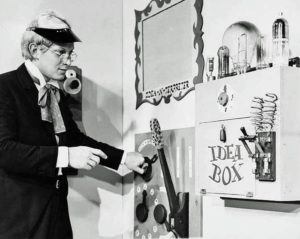 younger sister Becky was rightfully jealous and hurt. That led to argument, tears, punishment, and more tears. However, the best memory is of all the switches, lights, buzzers, and bells that sounded on the panel.
younger sister Becky was rightfully jealous and hurt. That led to argument, tears, punishment, and more tears. However, the best memory is of all the switches, lights, buzzers, and bells that sounded on the panel.
Of the 40 or so programs chronicled, over half of them are recall-rooted. So revered is Murray Nolte’s Dr. N. Ventor show, featuring the doddering doctor’s inventions and those great black and white cartoons. John Bilyeu’s kids’ shows somehow escape me, but Bilyeu and Channel 9 are inseparable. He was around KMBC for a long time, doing a variety of TV duties, superbly so. It is good to see him recently interviewed.
Then there is Whizzo, forever it seems, on Channel 9. Frank Wiziarde’s clown persona entertained Kansas City 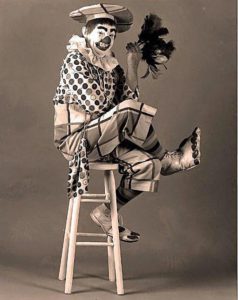 “children of all ages” for 30 years. Like many locals, I saw Whizzo in person numerous times, but never actually got to talk to him. There were several parades I witnessed, some even down Minnesota Avenue, that included the great clown.
“children of all ages” for 30 years. Like many locals, I saw Whizzo in person numerous times, but never actually got to talk to him. There were several parades I witnessed, some even down Minnesota Avenue, that included the great clown.
What a brilliant acrobat and stream-of-consciousness wit. Cut from Dibble’s documentary is a recording I loaned him of a pre-Whizzo Wiziarde hosting the late 1940s local Luncheon on the Plaza radio show which includes my 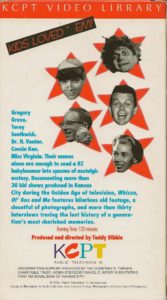 mother as one of the hat-wearing guests. Hearing the radio show, it is difficult to picture Wiziarde’s voice connected to anyone but his clown character. The quick wit and style were pure Whizzo.
mother as one of the hat-wearing guests. Hearing the radio show, it is difficult to picture Wiziarde’s voice connected to anyone but his clown character. The quick wit and style were pure Whizzo.
What a kick to see a recent interview with KCMO’s Ken Motley, and clips of his fun afternoon daily, Cousin Ken’s Carnival. Remember his introduction to a Warner Brothers cartoon with his slide whistle voice sound? Those of you under 40 might not understand.
By the time Torey and Ol’ Gus took center spotlight, I was in junior high, a little too old to really appreciate their talents. The tape clips featured in the documentary, however, prove that I really missed out by not tuning in more often.
Clearly, Torey, Ol’ Gus, Whizzo, and a cadre of local talents could have have been appreciated and loved on a national scale.
But they were and are ours, exclusively. Forever.

